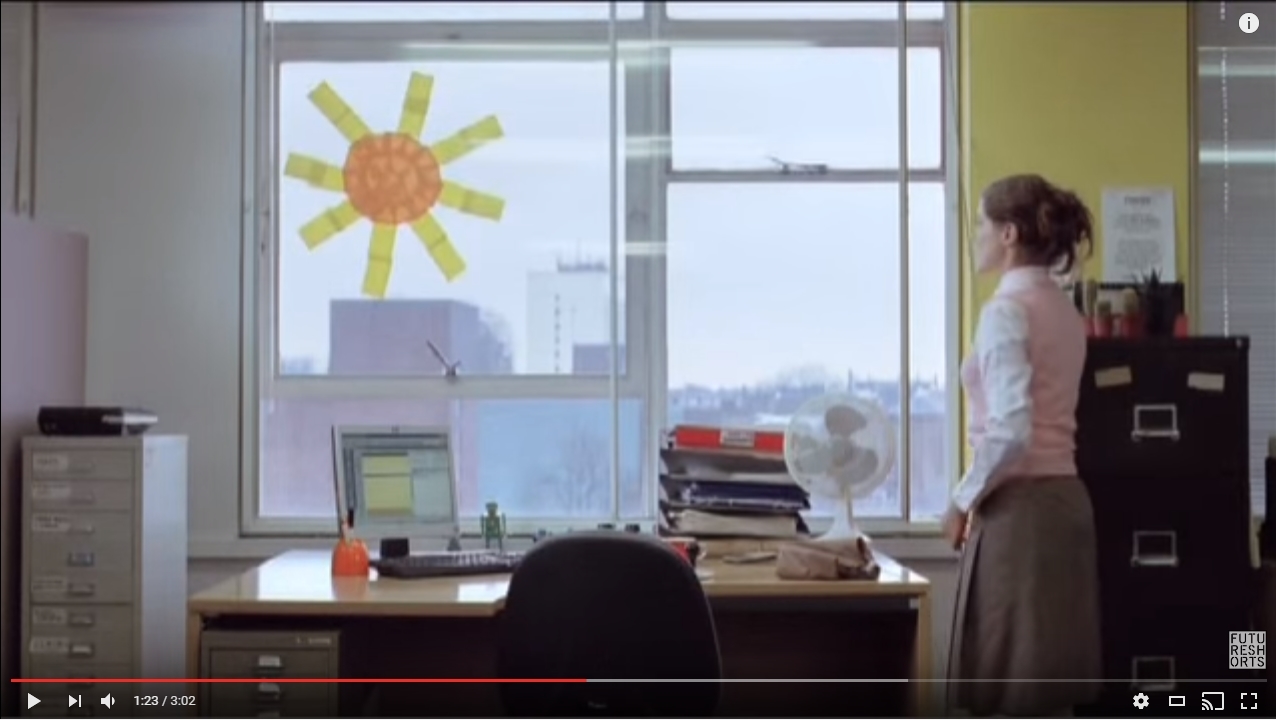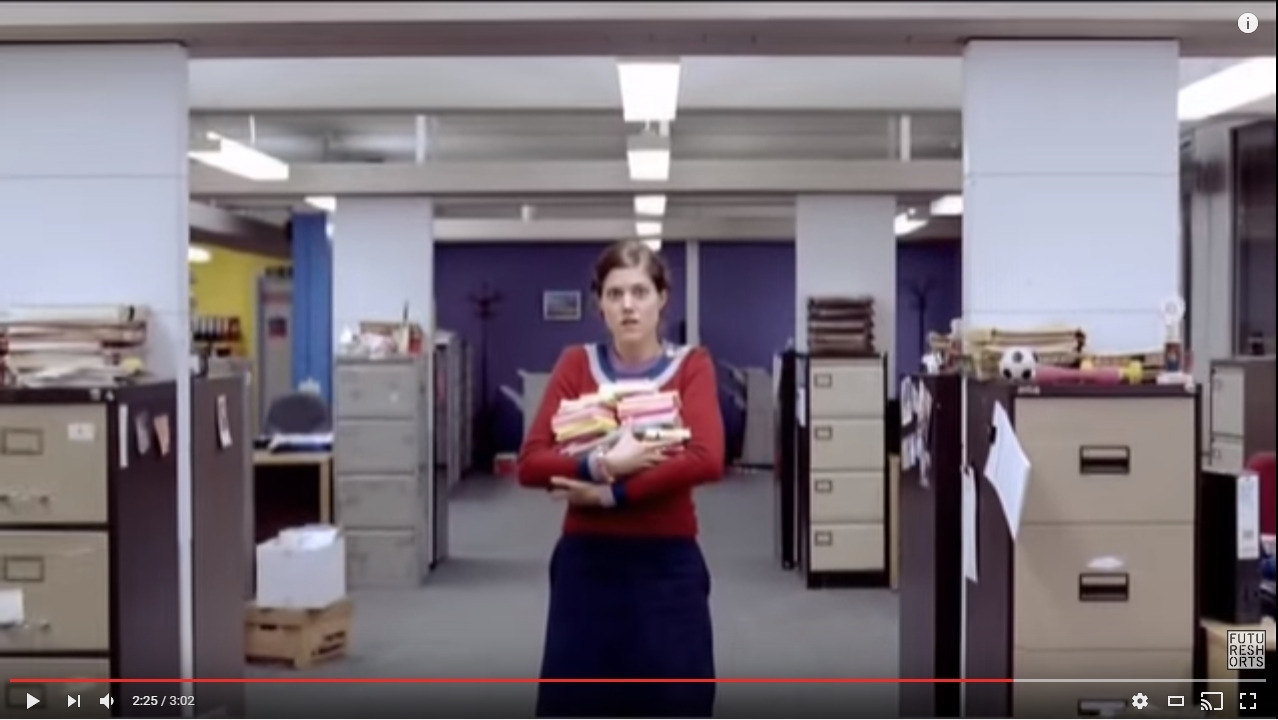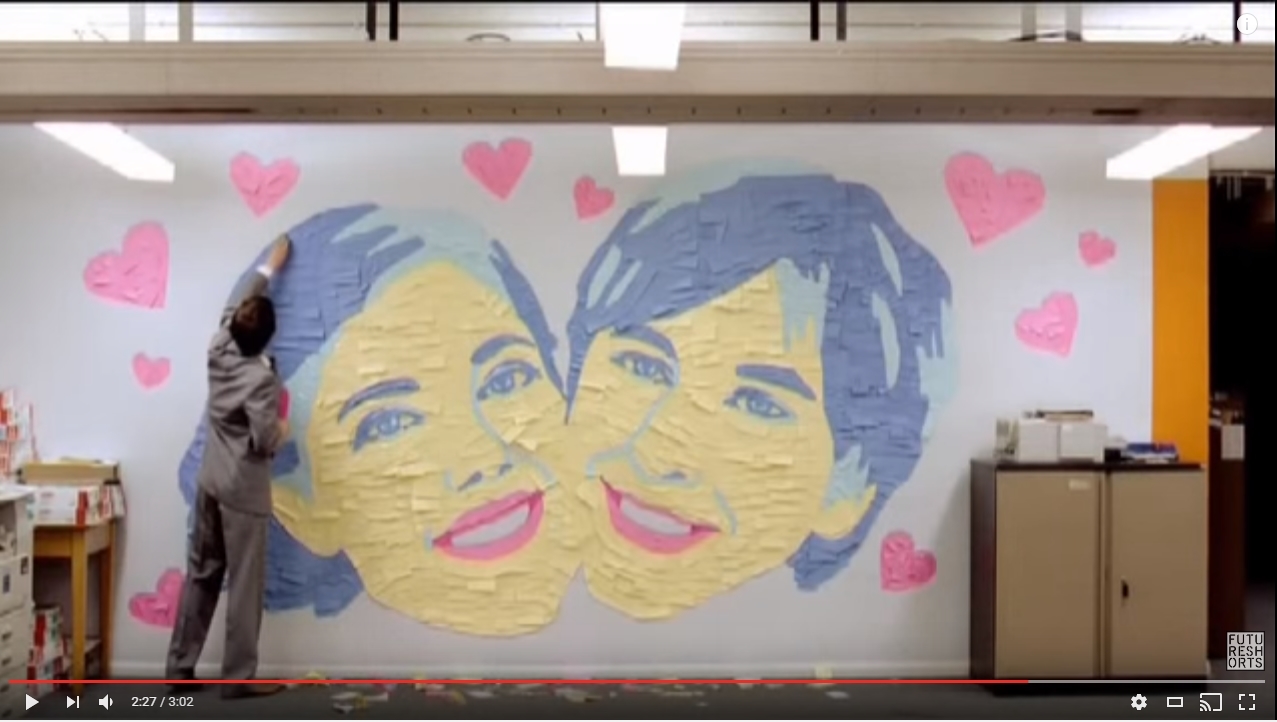Post-it Love Analysis
Post-it Love, Simon Atkinson & Adam Townley, 2008
Post-it Love is a three-minute short romance film. The film shows us a short story about how a relationship develops between two shy office workers, which show their affection for each other without saying it overtly. They do this through making images for each other through post-it notes until one of the characters sees the other while they're making an extravagant image of both of them together.


Narrative in Post-it Love:
The narrative in post-it love is linear, it follows a set of events that are chronological with closure.
Post-it love loosely follows Todorov's narrative theory, the equilibrium at the beginning of the film is shown when both of the characters are stood at the printers without paying attention to each other. At this point it can be assumed that they have never talked before, as they look shyly at each other across the half wall. The disruption to the equilibrium is when they look at each other and realise a mutual affection between them. The confrontation takes place throughout the rest of the film, with the two characters showing their affection to each other through making pictures out of post-it notes in different places for each other. The resolution takes place almost during the confrontation, when the male character is making an almost mural-like picture of him and the female character together out of post-it notes, the female character sees him doing it and they share a moment together, though the film ends here it can be assumed that a new equilibrium has been reached between the two characters.

Genre in Post-it Love:
In Post-it Love there are many good examples of genre and how it can be used to make a good film. One of the first examples of genre in this short film is where we see a bird's eye view of the female character using the photocopier, the camera pans across to the male character to reveal that he is doing the exact same actions on a different copying machine. This is almost a graphic match between the two characters and their movements, however, they are in the same frame which makes this unusual. This event shows a connection between the characters from the beginning.From the start of the film, there is a non-diegetic soundtrack, the song which is playing is very typical of a romance film like this. This gives the viewer some idea of genre as soon as the film begins to play. Another thing that gives away the genre of the film is the film's title, having the word 'love' in it immediately indicates that this is a romance film.

Another semantic device used in this short film is where the eyes of the two characters meet over the short wall and they both shyly look away from each other. This is commonly used in romance films as a way of showing that two characters have a romantic interest in the other but they are too shy or embarrassed to mention it.
In the next scene, the male character finds a simple face made out of post-it notes on his desk and looks around for who had put it there. As he looks, he once again catches the female characters eyes and quickly looks away. This time, however, we can see the male characters facial expression, it shows that the event has made him happy, and we can see that he is thinking of ways to do the same thing for the female character. In the next scene, we see the female character put her things on her desk, she then opens her blinds to reveal a sun made out of post-it notes on the window in front of her. This increasing extravagancy is what eventually leads to the characters having the same idea and meeting.

Media Language in Post-it Love:
The title scene in Post-it Love is very simple, it shows a framed picture of an office building, with title of the film in text just above it. The first shot in the film is a close-up of the female characters face, we can see through her costume that she is in work attire. In this shot the female character is looking downwards, this body language shows her shyness in the situation, though at this point the audience is not told what the situation is.The next scene we see is a medium shot with both of the characters in frame, they are partitioned by a wall in the center of the frame. The mise on scene in the scene is mirrored on either side of the wall, with both of the characters making identical movements. As mentioned earlier, both of the characters moving in the same way creates a kind of graphical match. This medium shot with both of the characters contained in it not only introduces us to both of the characters but shows us a similarity between the two of them.

The next shot we see is a close-up of the female character's profile with the male character visible in the background. There is a focus pull between the two characters as we see them both shyly react to each other. Next, we see a medium shot from the perspective of the male characters desk as he walks towards it, we see him open a folded piece of paper with a confused expression on his face. This shot creates a small amount of enigma the audience is wondering what is on the paper, which is then revealed to us through a POV shot/eye line match of the male character's perspective.
We next see a tracking shot of the male character as he moves on his chair to try and find who left the paper on his desk, which is then revealed to use through a focus pull to the female characters face, who is once again making the same movements as him.

In the next scene, we see the woman approaching her desk in the same manner that the man did, to find another picture made out of post-it notes on her window. At this point the pace has decreased through a reduction in shot frequency. We next see a medium shot of the male character from the perspective of a mirror he is looking into in the bathroom as he's straightening his tie. A toilet stall door is closed revealing another piece of post-it art which has been made on it.

The next shot begins in complete darkness, as we see the female character open a door into the room which the camera is positioned in closing the door behind her before turning on the lights. Her turning on the lights after the door is closed shows that it is likely she is doing something that may be dishonest or not allowed. When the lights turn on we see an ECU of her eyes focusing and her pupils becoming more constricted, we also see her cheek bones rise showing through her facial expression that she is smiling without showing the lower half of her face. We then cut to a MCU shot positioned behind the female character, there is another piece of post-it art depicting a flower which is placed on the wall opposite her. The art and the shot are placed so that when she is holding the light switch chord it looks like she is holding the flowers in her hand since flowers have romantic connotations this is another sign of the developing romantic interest between the two characters.

Next, we see a slow tracking shot as the female character has her arms full of post-it notes, she is travelling somewhere to make something extravagant out of them. This shot has a shallow depth of field, emphasizing the character's nervous facial expression. We next see a POV of the final piece of post-it art that the man is still currently making, it is a giant mural like picture of both of the characters faces together. We see the man turn around and realise that the female character has been watching him, and see several close up shots of their facial expressions as they are both smiling.

Well done Jacob - good work here, and all 5 completed by the deadline :) Keep it up and you could achieve a really good grade on research and planning.
ReplyDelete